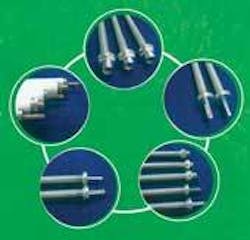Condensate Polishing Filtration Systems for Power Generation Applications
by Jeffrey Selder
In many areas around the world, where water resources are scarce or require reuse, it’s advocated that technology be used to treat industrial process water. For example, in the arid regions of China, the National Development and Reform Commission (NDRC) advocates all newly built coal-fired power plants adopt “pollution” control technology. As a result, use of powdered-resin condensate polishing systems has become widely prevalent in recovery and recycling of the return condensate stream on the steam condensate loop in industrial power generation systems. Careful purification of this stream to remove contaminants greatly reduces operating costs and can prevent damage to the system that’s typically manifested via corrosion or steam leaks.
Features of powdered-resin filtration systems include: large operating capacity; effective removal of organic matter and colloid silicate; effective removal of corrosion products from the thermodynamic system; and ferric oxide removal rates of 95% or higher. These systems utilize powdered resins capable of achieving high regeneration rates. They’re typically precoated onto the surface of fiber filter elements and also have the ability to act as both ultrafiltration and ion exchange systems.
Advantages powdered-resin condensate polishing filtration systems have over high-speed, mixed-bed filtration systems, for example, include: minimal space requirement; reduced capital investment; reduced operating cost; and simple system operation for ease of use and maintenance.
Precoat Techniques
There are three main technologies:
- Bidirectional Precoat Technology: Service water inlet lies in or at the bottom of the filter vessel; via a split stream, a portion of the inlet water enters the filter chamber through the distribution plate from below, while the remaining fluid enters the filter chamber through a connecting pipe from the top of the filter vessel. As a result, powdered resin can be precoated on the filter element surface from both ends. This application method results in even formation of precoat on the surface of elements, which can be as long as 1,788 mm in length.
- Precoat Flux Adjustment Technology: An adjustable plate is installed in the top of the filter vessel (above the connecting pipe), which can be used to adjust water distribution between the top and bottom ends of the elements. If, for example, the upper precoat of the filter elements becomes overly thick, this tells maintenance people the upper flow rate is too high; the adjustable plate can then be raised or lowered according to process requirements.
- Reliable Sealing Technology: This is accomplished through use of special thermal-resistant soft glue that’s applied on the bottom of the filter elements prior to spinning the elements onto the dome of the filter housing’s false bottom. This approach eliminates leakage of powdered resin and ensures safe equipment operation.
The Filter Media
Although there are various solutions available for removal of contaminants and impurities from the condensate process stream, filter elements constructed of wound yarn are often still an excellent choice. This type of element can be manufactured in various lengths ranging in size from 4" to 80" and in a variety of different retention ratings from 1 to 150 microns. The typical honeycomb structure of the filter body gives it a considerable capacity for accumulating impurities present in the process stream. Large foreign particles are trapped on the surface, while smaller particles are captured within the filter’s deeper sub-layers. This type of filter can be produced in different yarns, according to the application for which they’re specified. Materials include, but aren’t limited to: polypropylene, rayon, cotton, nylon and fiberglass. The inner perforated core, which supports the wound material, also can be supplied in polypropylene, tin, 304SS, 316SS, etc. - again, according to the requirement of the application. As mentioned above, for condensate polishing applications in power plants, the elements can be easily pre-coated with inert or powdered resins at a rate of 1,000 dry g/m2, thereby providing a degree of flexibility for operators. To maximize economic efficiency and lengthen filter life, backwashing of the filter elements can be performed with either air or water.
Conclusion
As many high-pressure boiler applications rely on condensate for the bulk of their boiler feedwater, powdered-resin condensate polishing filtration systems can be an essential and cost-effective component in the supply of high quality feedwater to the downstream boiler.
About the Author: Jeff Selder is chief operating officer of Pepso Advanced Filtration Co. Ltd., of Vancouver, Canada. Contact: 604-801-5238 or www.pepso.net

